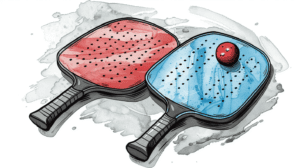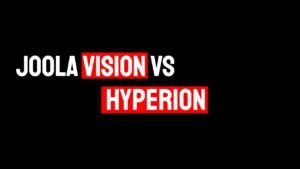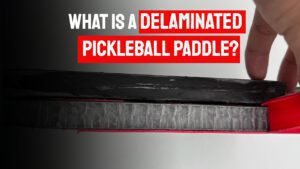Graphite vs Fiberglass Pickleball Paddles – Explained

Last updated
Choosing between graphite and fiberglass pickleball paddles?
Graphite paddles offer lightweight precision, which is ideal for players who focus on control. Fiberglass paddles provide durability and power and are better suited for aggressive play.
Here’s a comparison to help you choose the right paddle for your needs.
KEY TAKEAWAYS
Fiberglass vs. Graphite Paddles
What Is Graphite in short?
Graphite is a crystalline form of carbon, known for its strength and lightness, making it ideal for sports equipment like pickleball paddles.
It offers precise control and responsiveness due to its rigidity, while its lightweight nature helps reduce fatigue.
The stiffness of graphite enhances contact with the ball, improving shot accuracy and durability for consistent performance.
What Is Fiberglass in short?
Fiberglass is a composite of fine glass fibers and resin, great for adding power and spin in pickleball. Its flexible nature efficiently absorbs and releases energy, boosting your shot strength.
Fiberglass paddles also feature a textured surface for better ball spin, offering a mix of effectiveness and affordability while being durable enough for intense gameplay.
What’s the Difference Between Graphite and Fiberglass Pickleball Paddles?
When deciding between graphite and fiberglass pickleball paddles, think of it as picking your dance partner for the court, where each has distinct characteristics that could influence your play.
Graphite paddles, exemplified by the popular CRBN 3X, are like agile dancers—light and precise, ideal for pickleball players who prioritize control and finesse.
Their honeycomb core and stiff graphite surface give a responsive feel, allowing you to connect with the ball crisply and execute quick, strategic manoeuvres.
In contrast, fiberglass paddles are the powerhouses designed to amplify your smash hits. A fibreglass paddle might be your best ally if your game strategy involves dominating the court with forceful shots.
Its flexibility contributes extra power, while the textured surface facilitates tricky spins, adding an inventive twist to your gameplay.
For those mindful of costs, fiberglass provides an affordable option without sacrificing the power and spin that many professional players rely on.
Are Graphite and Fiberglass Paddles Good for Beginners?
For those just starting out in pickleball, the choice between graphite and fiberglass paddles boils down to what feels suitable for your style of play.
A graphite option might be your best bet if you’re drawn to a lightweight and precise paddle. Its maneuverability can help you get a handle on shot placement and finesse, boosting your skill development in a fun and engaging way.
If you’re still getting the hang of powering through your shots, the forgiving nature of a fiberglass paddle can be a real game changer.
Its flexibility makes it easier to use, which is perfect when you’re still learning the ropes.
Which Paddles Are Better: Graphite or Fiberglass?
Deciding on the best pickleball paddle can feel like navigating a maze, but we’re here to light the way.
When torn between graphite(1) and fiberglass(2), consider what matters most to you regarding performance, durability, and core materials.
Graphite paddles shine with their snappy response and lightweight design, boosting your agility and precision on the court. They’re a top pick for players who want to up their game with quick, controlled movements.
On the other hand, fiberglass paddles stand out for their durability, holding up well under the demands of any play style—from casual hits to competitive clashes.
Their textured surface can be a game-changer for those who like to throw in some spin, giving you an edge in those nail-biting matches.
The core of your paddle—be it polymer, Nomex honeycomb, or aluminum—affects everything from the sweet spot to how the paddle transfers energy during play.
This choice impacts the paddle’s weight and how it feels during a game, tailoring your experience to your style.
Which Material Is Best for a Pickleball Paddle?
Choosing the suitable material for your pickleball paddle boils down to your style and what you value most on the court.
Graphite paddles might be your best bet if precision and lightness are on your list. They’re known for delivering sharp, controlled shots consistently.
On the other hand, if you’re all about spin potential and a generous sweet spot, fiberglass paddles could be your go-to.
Why Choose Graphite?
1. Enhanced Control: Graphite paddles’ stiffness allows for superior ball control, making it easier to place shots accurately.
2. Quick Maneuverability: The lightness of graphite paddles enables faster reactions and quick adjustments during play.
3. Less Fatigue: Their lightweight design makes graphite paddles easier to handle over long periods, reducing arm and shoulder strain.
4. Crisp Ball Contact: The graphite surface offers a firm feel, providing immediate feedback on ball contact, which can improve shot consistency.
Why Choose Fiberglass?
1. Increased Power: Fiberglass paddles’ flexible nature adds extra power to your shots, making it easier to drive the ball with force.
2. Spin Potential: Fiberglass paddles’ textured surface allows for greater spin control, enabling more varied and tricky shots.
3. Affordability: Generally, fiberglass paddles are more cost-effective, providing high performance without a high price tag.
4. Versatility: Fiberglass paddles offer a balanced mix of power and control, catering to players who like a dynamic and aggressive playing style.
Which Material Should a Beginner Choose?
Starting your pickleball journey? Picking the right paddle can feel like a puzzle.
Graphite paddles are a prime choice if precision and a lighter touch catch your interest.
These paddles are perfect for players eager to sharpen their skills and manage their energy on the court.
Mastering power strokes with graphite might take some practice. Still, the control and quick response you gain are worth the effort.
Conversely, consider fibreglass paddles if you’re easing into the sport and prefer a more forgiving tool.
They usually feature a more prominent sweet spot, giving you more room to perfect your shots as you play.
While the sleek control of graphite is appealing, the sturdiness and power boost from fibreglass could better match your evolving style as a new player.
Reflect on your goals—control or power—and ensure your paddle choice fits your budget and supports your growth in the game.
Graphite vs Fiberglass Pickleball Paddles Conclusion
When deciding between graphite and fiberglasspickleball paddles, your choice is a matter of personal preference, reflecting your specific playing style and needs.
Graphite paddles are ideal for players who prioritize precision and control. In contrast, fiberglass paddles offer more power and durability, catering to those who play aggressively or are still refining their skills.
Both fiberglass and graphite bring distinct benefits to the court, so it’s crucial to consider how each type of equipment aligns with your technique and objectives.
I hope this tips will help you make an informed choice, ensuring that the paddle you select complements your style and enhances your overall game experience.
Choose wisely, as the right paddle can significantly impact your performance and enjoyment of pickleball.







